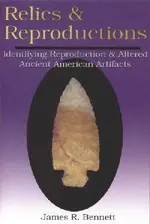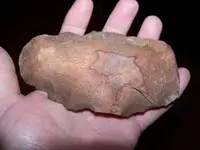bravowhiskey
Bronze Member
- Joined
- May 29, 2009
- Messages
- 1,452
- Reaction score
- 952
- Golden Thread
- 0
- Location
- Brazos Valley, Texas
- Detector(s) used
- Minelab Explorer SE
how do you pro's tell a reproduction....
I want to know how it is done. Now, even a rank amateur can tell a precut slab if there is part of the cut showing. The marks are obvious. The cutting blade leaves striations obvious even without magnification. Here is an example:

I have noticed also, a lot of real points and even scrapers are not exactly flat, but can retain a good portion of the "bend" in the flake that has been removed from the core. they can come out pretty warped looking at times. That to me is authenticity. Example 2:

Also a flake removed from a core has an absolutely smooth face to it, with no striations. Here is one of my favorite, recently found, uniface scraper/knife? that illustrates that very well:

additionally a piece with a bit of the cobble/core still attached is a great indicator, see below:

Folks speak of "patina" which is brought about by age and the material in which it lay over the years.
While I am not from Missouri, I still want to say...show me. Some artifacts it would seem obvious and others not so much. Please someone...a good example of this with a professional explanation.
Can you pro's please explain further with some good examples of other discernable differences between a repro and an authentic piece for us rookies. Also if I am off on anything I have said please tell me. These things I figured out for myself and may still be wrong. I certainly am not opposed to critique, but welcome it.
May the Gods of knowledge smile down upon us.
BW
I want to know how it is done. Now, even a rank amateur can tell a precut slab if there is part of the cut showing. The marks are obvious. The cutting blade leaves striations obvious even without magnification. Here is an example:

I have noticed also, a lot of real points and even scrapers are not exactly flat, but can retain a good portion of the "bend" in the flake that has been removed from the core. they can come out pretty warped looking at times. That to me is authenticity. Example 2:

Also a flake removed from a core has an absolutely smooth face to it, with no striations. Here is one of my favorite, recently found, uniface scraper/knife? that illustrates that very well:

additionally a piece with a bit of the cobble/core still attached is a great indicator, see below:

Folks speak of "patina" which is brought about by age and the material in which it lay over the years.
While I am not from Missouri, I still want to say...show me. Some artifacts it would seem obvious and others not so much. Please someone...a good example of this with a professional explanation.
Can you pro's please explain further with some good examples of other discernable differences between a repro and an authentic piece for us rookies. Also if I am off on anything I have said please tell me. These things I figured out for myself and may still be wrong. I certainly am not opposed to critique, but welcome it.
May the Gods of knowledge smile down upon us.
BW
Upvote
0











